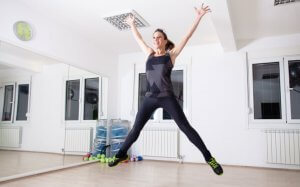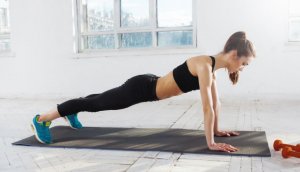Functional Body: How to Get One and Reap the Benefits

A functional body is one that allows you to do any kind of exercise or activity without pain or impediment. In this article, we’ll tell you how to get one so that you can feel good, both physically and mentally. Keep reading to lean more about how to achieve a functional body.
What is a functional body?
For starters, it’s a good idea to establish the definition of a functional body. Simply put, it’s a body that enjoys significant development in terms of strength, flexibility, coordination, speed, agility, balance, and endurance. Almost like a superhero!
If achieving these things seems impossible to you, as though you’d have to spend all of your waking hours working out, don’t worry! The truth is that, with daily exercise and consistency, you can achieve a functional body. In any event, your goal should be to reach your full potential, and correct whatever’s stopping you from enjoying a great figure.

What are the advantages of a functional body?
Perhaps you’re thinking that a functional body isn’t for you, and you’re not the type to spend hours upon hours exercising? However, you may change your mind when you learn that its benefits aren’t confined to what happens in the gym.
1. It translates to real life
This is the first advantage that will help you decide to work toward a functional body. Generally speaking, it will have a positive effect on any situation that arises in your daily life. From carrying heavy bags home from the supermarket, to running to catch a bus, it makes a difference. It has a positive effect on activities such as playing with your children and taking your dog for a walk. It’s always a good idea to maintain a strong and agile body.
2. It corrects your posture
Nowadays, neck and back pain is more common than ever, as we spend hours either in front of the computer or standing at work. With an integral (or functional) routine, we work out all of our muscles, but particularly all the stabilizers. That is to say, the muscles in the body’s midsection.
Therefore, a functional body will correct your posture, prevent muscle pains and spasms, and even help to improve bone conditions like scoliosis. Meanwhile, it also helps to prevent injury by toning the muscles and lifting weight during the routine.
3. It will allow you to do every kind of exercise
Another advantage of a functional body is that it adapts to any discipline that you might want to practice. Although you may find it hard to believe, you’ll experience improved performance in a variety of athletic activities.
One of the best-known examples is martial arts: boxing, karate, kickboxing, and Muay Thai. The speed of the movements, the improved strength, the flexibility, the reflexes, and the endurance will all combine to make you a champion.
You’ll also notice improvements in other sports, such as soccer, tennis, basketball, and hockey. Pay attention to the physiques of modern athletes: they’re more athletic, carry no accumulated fat, and feature optimal muscle mass.
How to achieve a functional body
Now that you know the benefits of a functional body, let’s get into the practical part. We’re referring to the moment you start working out in order to achieve this goal. Keep in mind that the results don’t happen overnight. Consistency and commitment are fundamental. A complete routine can include the following exercises:
1. Squats
You’re probably already familiar with this exercise, a staple of many routines. In this case, you need to do 50 repetitions of normal squats for the first few weeks. Later, add weight (for instance, a kettlebell), and increase the number of repetitions.
2. Jumping in place
This is the kind “with your knees at your chest,” which increases your heart rate, makes you sweat, and, above all, works the leg muscles and glutes. Do 50 repetitions.

3. Burpees
This is one of the most complete cardio exercises. Do 30 in a row as fast as you can, without stopping between repetitions.
4. Running in place
Go as fast as you possibly can, as though you were sprinting. The idea is to maintain the movement for at least a minute.
5. Push-ups
Finally, this classic exercise allows us to strengthen our biceps and triceps. Do 40 repetitions with your legs stretched out.

If you want a functional body, repeat this routine three times a week for at least a month. Then, intensify the exercises by adding weight and increasing the number of repetitions.
A functional body is one that allows you to do any kind of exercise or activity without pain or impediment. In this article, we’ll tell you how to get one so that you can feel good, both physically and mentally. Keep reading to lean more about how to achieve a functional body.
What is a functional body?
For starters, it’s a good idea to establish the definition of a functional body. Simply put, it’s a body that enjoys significant development in terms of strength, flexibility, coordination, speed, agility, balance, and endurance. Almost like a superhero!
If achieving these things seems impossible to you, as though you’d have to spend all of your waking hours working out, don’t worry! The truth is that, with daily exercise and consistency, you can achieve a functional body. In any event, your goal should be to reach your full potential, and correct whatever’s stopping you from enjoying a great figure.

What are the advantages of a functional body?
Perhaps you’re thinking that a functional body isn’t for you, and you’re not the type to spend hours upon hours exercising? However, you may change your mind when you learn that its benefits aren’t confined to what happens in the gym.
1. It translates to real life
This is the first advantage that will help you decide to work toward a functional body. Generally speaking, it will have a positive effect on any situation that arises in your daily life. From carrying heavy bags home from the supermarket, to running to catch a bus, it makes a difference. It has a positive effect on activities such as playing with your children and taking your dog for a walk. It’s always a good idea to maintain a strong and agile body.
2. It corrects your posture
Nowadays, neck and back pain is more common than ever, as we spend hours either in front of the computer or standing at work. With an integral (or functional) routine, we work out all of our muscles, but particularly all the stabilizers. That is to say, the muscles in the body’s midsection.
Therefore, a functional body will correct your posture, prevent muscle pains and spasms, and even help to improve bone conditions like scoliosis. Meanwhile, it also helps to prevent injury by toning the muscles and lifting weight during the routine.
3. It will allow you to do every kind of exercise
Another advantage of a functional body is that it adapts to any discipline that you might want to practice. Although you may find it hard to believe, you’ll experience improved performance in a variety of athletic activities.
One of the best-known examples is martial arts: boxing, karate, kickboxing, and Muay Thai. The speed of the movements, the improved strength, the flexibility, the reflexes, and the endurance will all combine to make you a champion.
You’ll also notice improvements in other sports, such as soccer, tennis, basketball, and hockey. Pay attention to the physiques of modern athletes: they’re more athletic, carry no accumulated fat, and feature optimal muscle mass.
How to achieve a functional body
Now that you know the benefits of a functional body, let’s get into the practical part. We’re referring to the moment you start working out in order to achieve this goal. Keep in mind that the results don’t happen overnight. Consistency and commitment are fundamental. A complete routine can include the following exercises:
1. Squats
You’re probably already familiar with this exercise, a staple of many routines. In this case, you need to do 50 repetitions of normal squats for the first few weeks. Later, add weight (for instance, a kettlebell), and increase the number of repetitions.
2. Jumping in place
This is the kind “with your knees at your chest,” which increases your heart rate, makes you sweat, and, above all, works the leg muscles and glutes. Do 50 repetitions.

3. Burpees
This is one of the most complete cardio exercises. Do 30 in a row as fast as you can, without stopping between repetitions.
4. Running in place
Go as fast as you possibly can, as though you were sprinting. The idea is to maintain the movement for at least a minute.
5. Push-ups
Finally, this classic exercise allows us to strengthen our biceps and triceps. Do 40 repetitions with your legs stretched out.

If you want a functional body, repeat this routine three times a week for at least a month. Then, intensify the exercises by adding weight and increasing the number of repetitions.
This text is provided for informational purposes only and does not replace consultation with a professional. If in doubt, consult your specialist.








